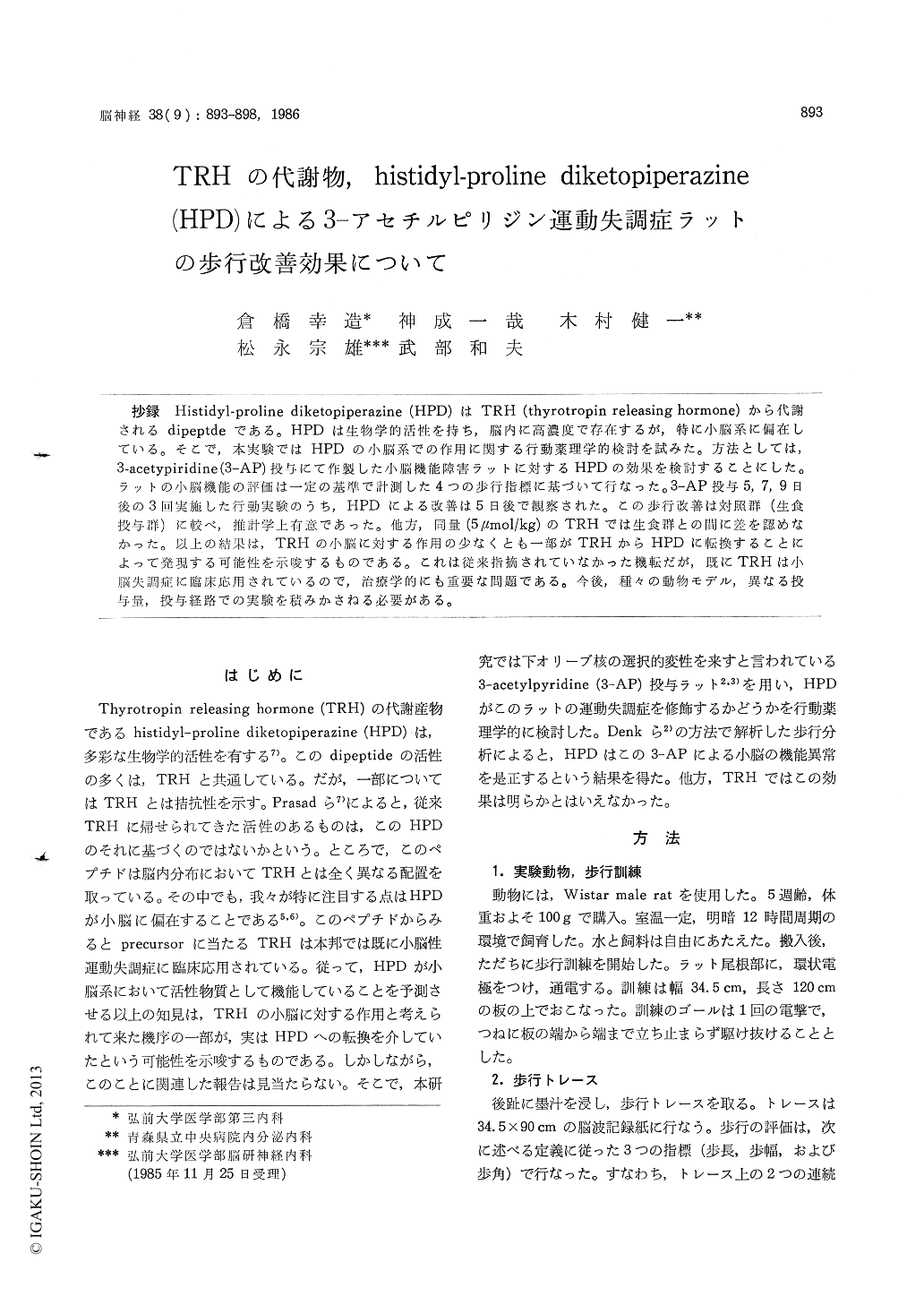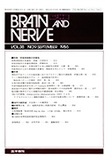Japanese
English
- 有料閲覧
- Abstract 文献概要
- 1ページ目 Look Inside
抄録 Histidyl-proline diketopiperazine (HPD)はTRH (thyrotropin releasing hormone)から代謝されるdipeptideである。HPDは生物学的活性を持ち,脳内に高濃度で存在するが,特に小脳系に偏在している。そこで,本実験ではHPDの小脳系での作用に関する行動薬理学的検討を試みた。方法としては,3-acetypiridine (3-AP)投与にて作製した小脳機能障害ラットに対するHPDの効果を検討することにした。ラットの小脳機能の評価は一定の基準で計測した4つの歩行指標に基づいて行なった。3-AP投与5,7,9日後の3回実施した行動実験のうち,HPDによる改善は5日後で観察された。この歩行改善は対照群(生食投与群)に較べ,推計学上有意であった。他方,同量(5μmol/kg)のTRHでは生食群との間に差を認めなかった。以上の結果は,TRHの小脳に対する作用の少なくとも一部がTRHからHPDに転換することによって発現する可能性を示唆するものである。これは従来指摘されていなかった機転だが,既にTRHは小脳失調症に臨床応用されているので,治療学的にも重要な問題である。今後,種々の動物モデル,異なる投与量,投与経路での実験を積みかさねる必要がある。
Histidyl-proline diketopiperazine (HPD) is the active metabolite deriving from thyrotropin-relea-sing hormone (TRH). However, its regional distri-bution in the central nervous system is quite different from TRH. Above all, it is to be noted that cerebellum is one of the richest region of HPD. In rat cerebellum, for example, the concen-tration of HPD is 20 times higher than that of TRH. This indicates the probable action of HPD within cerebellar system. Recently, a fascinating hypothesis has been proposed by Prasad et al that some activities of TRH are based on its conversion to HPD. The purpose of this experi-ment is to clarify whether the hypothesis may also be appropriate for the action in the cerebellar system.
Twenty four Wistar rats treated with 3-acetyl-pyridin (3-AP) intraperitoneally were used in our experiment. Before 3-AP administration, those rats were conditioned by electric stimulation to run forward. The 3-AP treated rat is established so as to make an ataxic rat along with a selective degeneration of the inferior olive nucleus. Those ataxic rats were devided into 3 groups accord-ing to the test drugs, that is, the group of HPD, TRH (5μmole/kg each), and saline [the same volume (3.6ml/kg)] control. Eight rats of each group received an intraperitoneal injection once a day from 5th to 9th day after 3-AP treatment. The behavioral tests were carried out at the 5th, 7th, and 9th day after 3-AP treatment. The ataxic gaits were observed every 30 minutes over 4 hours in succession. For the evaluation of the ataxic gaits, each gait was printed on a paper with hindlegs soaked in black-ink and simultaneuosly recorded using a video movie. Assessment parame-ters were the length, width, angle, and speed.
The group treated with HPD showed a signifi-cant improvement of ataxic gait at 5th day test after 3-AP treatment, compared to the control group treated with saline. However, the alleviation was not demonstrated at the following tests when the state of ataxia became more deteriolated. On the other hand, the TRH could not improve the gait ataxias over the period of experiments.
From our results, we concluded that (1) there exists a pharmacological discrepancy between HPD and TRH on the 3-AP induced cerebellar dysfunc-tion, namely, the effect of HPD is apparent but that of TRH is questionable. However, HPD was not efficient enough to interfere the progression of ataxia, because HPD failed to improve the more deteriolated ataxia.
In conclusion, the hypothesis that HPD may be a real active form of TRH is compatible even with the cerebellar system.

Copyright © 1986, Igaku-Shoin Ltd. All rights reserved.


